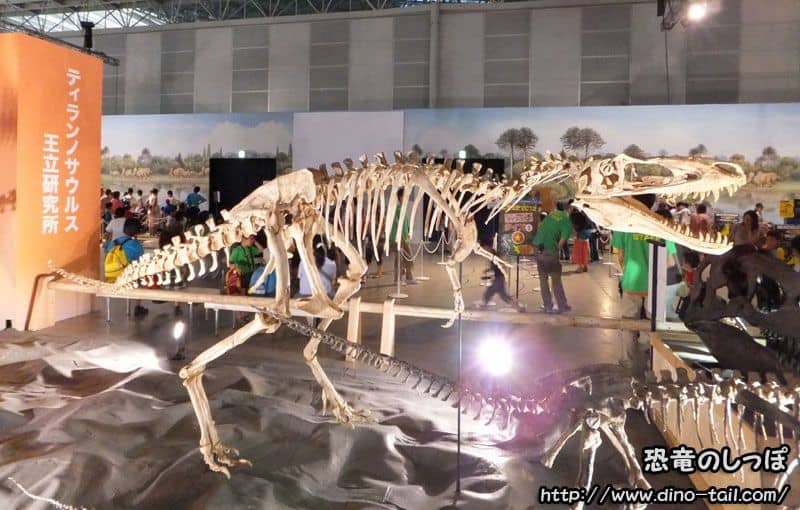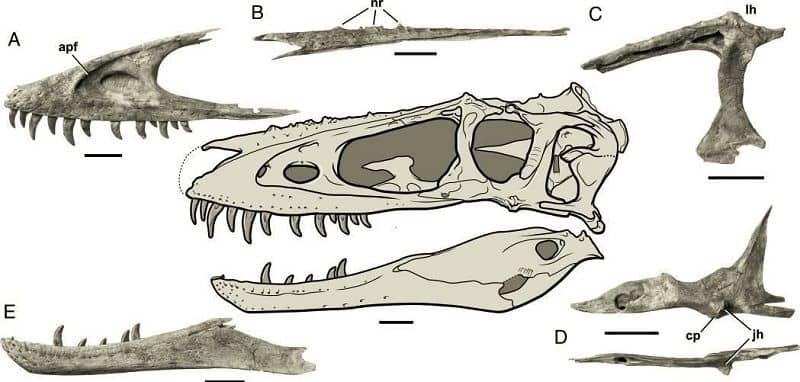About Alioramus
| Scientific Name (Genus) | Alioramus |
| Meaning of Name |
Different branch
alius (different) [Latin] - rāmus (branch) [Latin] |
| Classification | Saurischia, Theropoda, Tyrannosauridae |
| Total Length | Approx. 5-6m |
| Diet | Carnivorous |
| Period | Late Cretaceous (approx. 70 million years ago) |
| Sub-classification/Species |
Alioramus remotus
Alioramus altai |
| Year of Paper Publication | 1976 |
| Genus Name Publication | Kurzanov, S. M. (1976). A new carnosaur from the Late Cretaceous of Nogon-Tsav, Mongolia. The Joint Soviet-Mongolian Paleontological Expedition Transactions, 3, 93-104. |
The Maverick of the Tyrannosaur Family

Alioramus was a tyrannosaurid dinosaur that lived in Mongolia during the Late Cretaceous. Its name means "different branch" in Latin, derived from its unique features that set it apart from other tyrannosaurs.
Its most striking feature is its long, slender snout and a series of five or more bony crests along the top of its nose. These crests were likely too fragile to be used as weapons and are thought to have served as display structures for species recognition or to attract mates.
It also had a delicate jaw and more teeth (about 76-78) than other tyrannosaurids. These skeletal features suggest it was a specialized hunter that targeted smaller, more agile prey, rather than crushing the bones of large animals.
The postcranial skeleton of Alioramus also indicates a slender and gracile build. The particularly long hindlimbs suggest an adaptation for agility and speed, suitable for chasing fast-moving prey. This contrasts with the thick, robust hindlimbs of larger tyrannosaurids, which evolved to support immense weight.
These anatomical features are not just a collection of oddities.
They form a coherent "adaptation" for a very specific ecological role: not a "brute-force mega-predator," but a "high-speed, precision hunter of smaller prey."
A lightweight skull, though unsuitable for crushing bone, allows for quick head movements. Blade-like teeth, while unable to shatter bone, efficiently slice through flesh. And a slender body with long legs provides the speed to catch such prey.
The entire structure of Alioramus beautifully illustrates a clear evolutionary divergence in feeding strategies within the Tyrannosauridae family.
During the time Alioramus lived, the larger and more robust tyrannosaurid Tarbosaurus also inhabited Mongolia. Alioramus may have evolved its unique form to occupy a different ecological niche, thereby avoiding direct competition for prey with Tarbosaurus.
Classification and Evolutionary Relationships - The Tyrannosaurid Lineage
The taxonomic position of Alioramus has significantly reshaped our understanding of tyrannosaurid evolution. It has revealed the existence of a previously unknown lineage of specialized predators.
For a long time, Alioramus was considered a member of the Tyrannosauroidea, but its exact position remained unclear due to the fragmentary nature of the initial fossils. However, the discovery of A. altai allowed for detailed phylogenetic analysis, solidifying its taxonomic status. The analysis showed that it belongs more specifically to the Tyrannosaurinae subfamily. This means that Alioramus is very closely related to giant predators like Tarbosaurus and Tyrannosaurus.
This has fundamentally changed our view of tyrannosaurid evolution.
Previously, the evolution of Tyrannosaurinae was often seen as a linear path towards larger, more powerful "bone-crushing" predators.
However, the discovery of Qianzhousaurus and Alioramus overturned this simplistic view.
The evolution of Tyrannosauridae was actually a complex process involving branching, and in Late Cretaceous Asia, it had evolved into at least two distinct predator ecomorphs (ecological morphotypes): the robust mega-predator and the gracile medium-sized predator. This indicates that the Tyrannosauridae had achieved a much higher level of ecological and morphological diversity than previously thought.
Analysis of the Alioramus Brain
In recent years, high-resolution computed tomography (CT) scans have been performed on the remarkably well-preserved braincase of the Alioramus holotype specimen. This technology allows scientists to observe the interior of the fossil without physically damaging it, creating a digital 3D model of the space where the brain was housed, called an "endocast." This endocast reveals the relative size and shape of the different brain regions, providing clues to infer the dinosaur's senses and behavior.
A Hunter's Sensory Capabilities
The findings from the endocast strongly support the inferences about Alioramus's ecology drawn from its skeleton. The brain of Alioramus, like that of other tyrannosaurids, was long and slender.
Particularly noteworthy was the conspicuously large space for the floccular lobe, a part of the cerebellum.
This brain region is responsible for balance, agility, and coordinating eye and head movements.
Its large size provides strong neurological evidence that Alioramus was an agile predator that required advanced motor control and a sharp sense of balance to track and capture fast-moving prey.
Furthermore, the structure of the bony labyrinth of the inner ear provides information about its auditory capabilities and sense of balance from the semicircular canals, allowing for a multifaceted analysis of its hunting style.
Insights into Evolution
The anatomical features of the Alioramus braincase revealed a combination of primitive theropod characteristics and derived features seen in the lineage leading to birds.
As a result, Alioramus was positioned between basal theropods and birds.
It provides invaluable data for understanding the evolutionary stages leading to the highly specialized brains of modern birds within the Coelurosauria lineage. For example, it has provided material for studying how features like the expansion of the cerebrum have evolved.
New Species Discovery and the Enigmatic Adult

Source: Brusatte, S. L. et al. (2009). A long-snouted, multihorned tyrannosaurid from the Late Cretaceous of Mongolia. PNAS, 106(41).
When the first species, Alioramus remotus, was described by a Russian paleontologist in 1976, the fossil was fragmentary, and some researchers thought it might be a juvenile Tarbosaurus. However, in 2009, a more complete skeleton was discovered in Mongolia and described as a new species, *Alioramus altai*. This specimen clearly showed features unique to Alioramus, such as more horns and numerous cavities within the skull, confirming it as a distinct genus.
Interestingly, all Alioramus fossils discovered so far are believed to be from young individuals (juveniles to sub-adults). Therefore, what a fully mature Alioramus looked like remains a mystery. For example, did the nasal horns become larger and more elaborate with age? Did the body become more robust? Many questions remain, and we await new discoveries.
